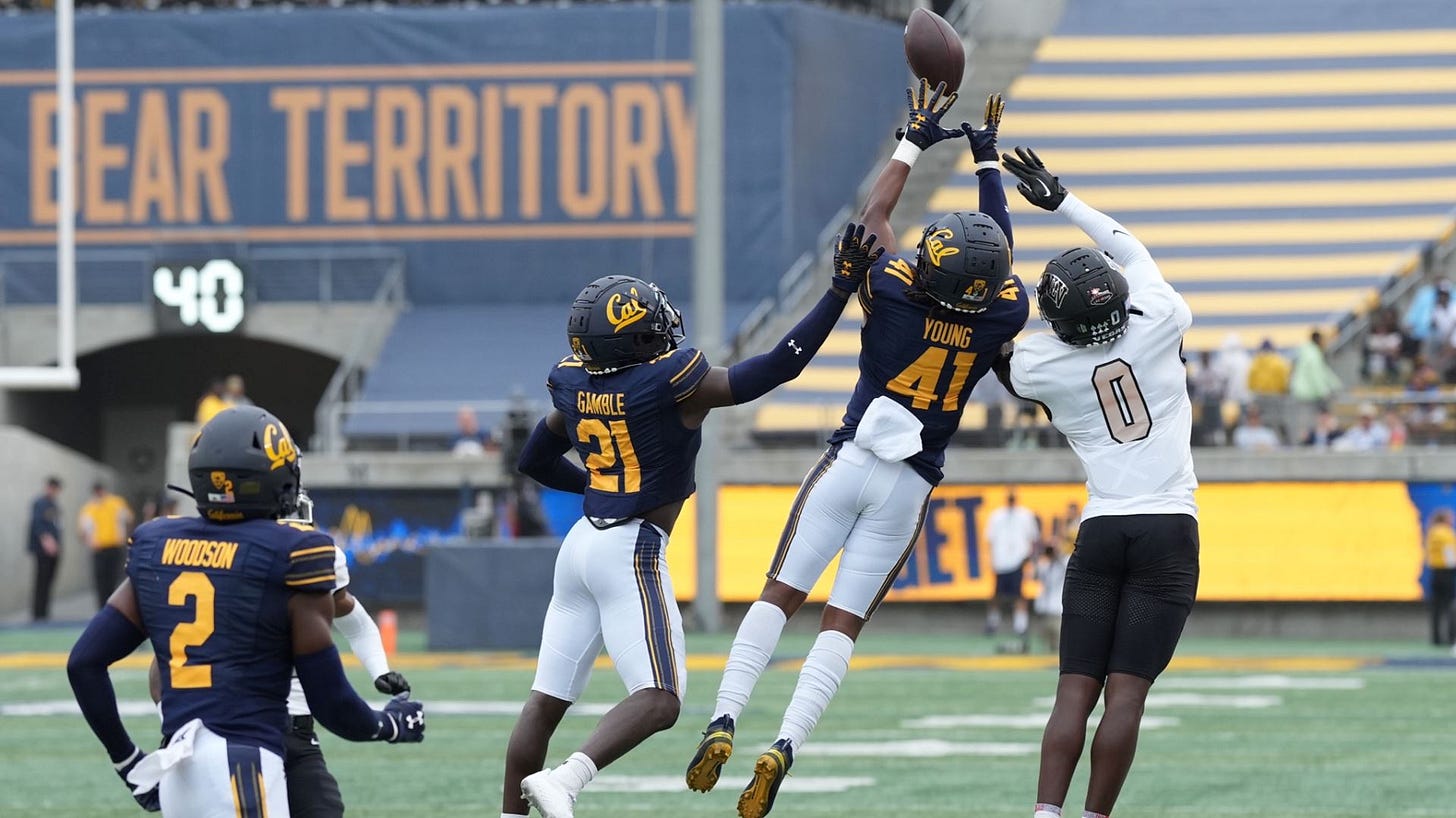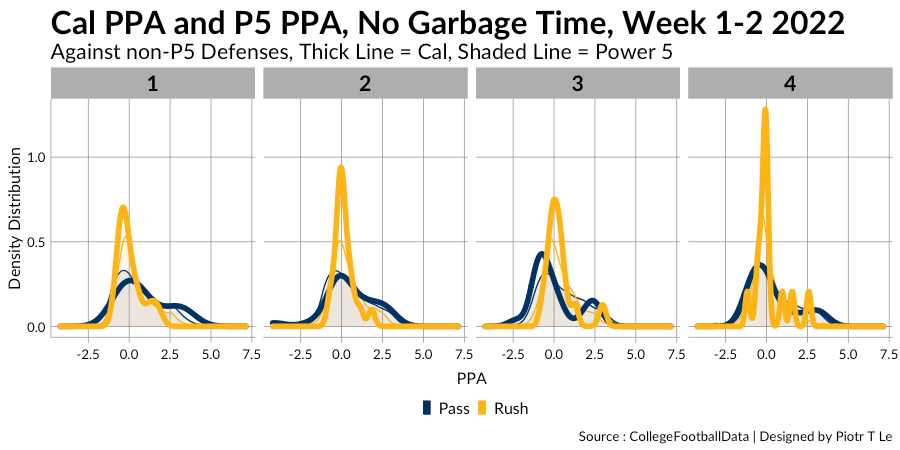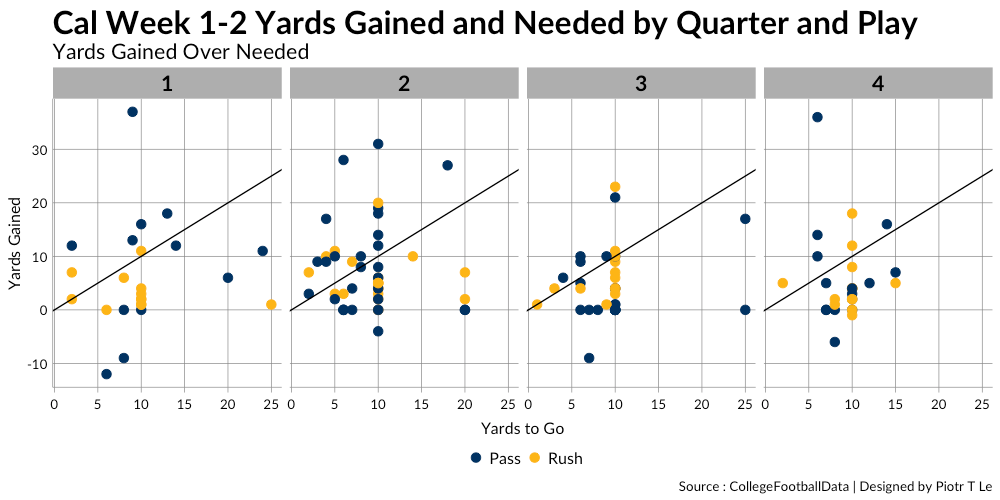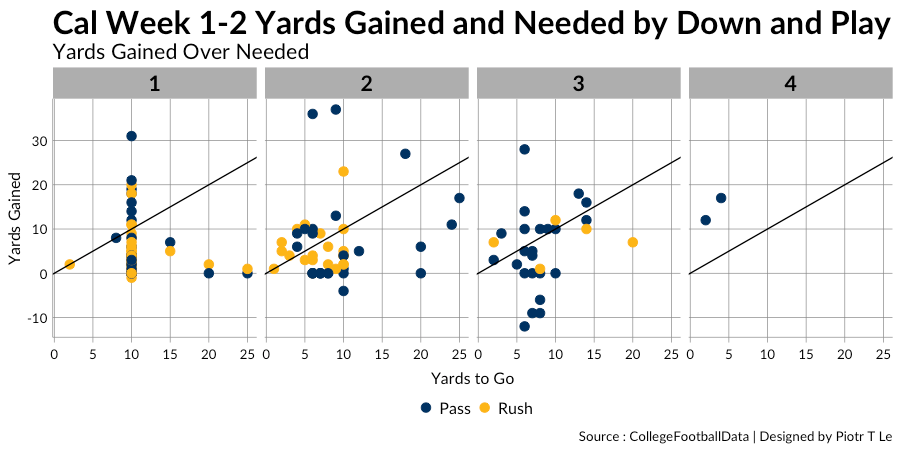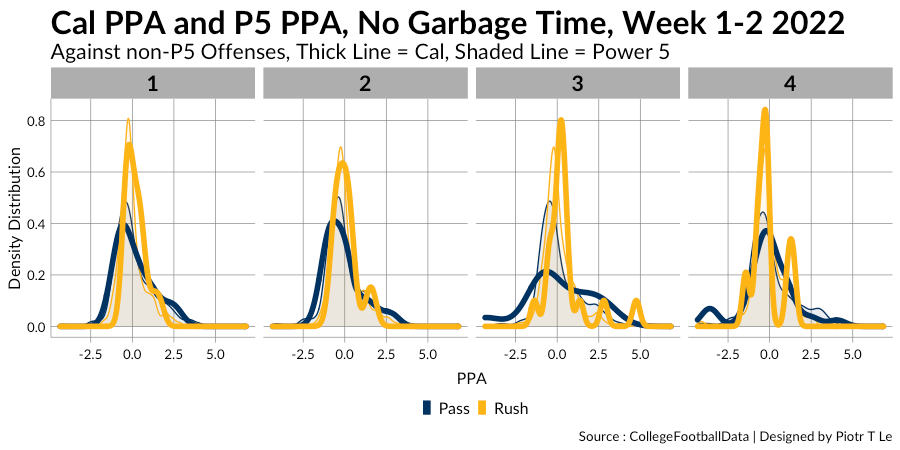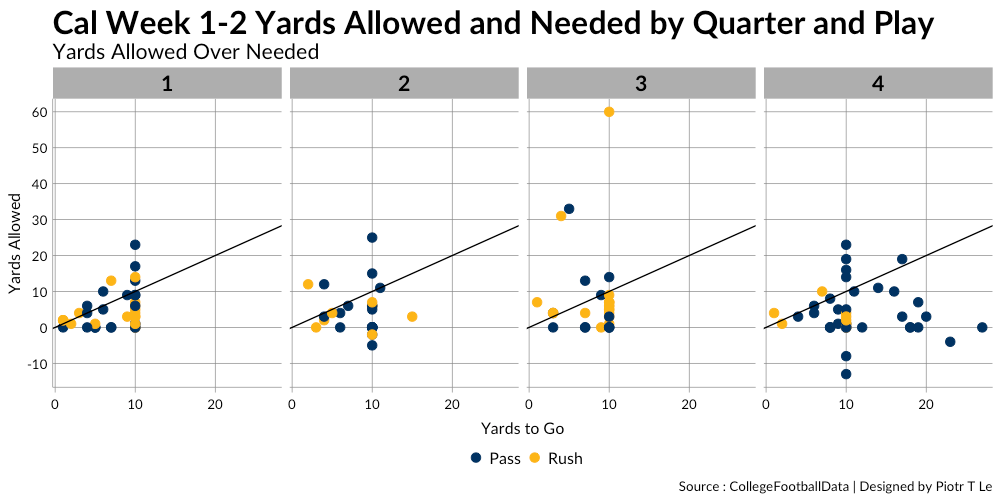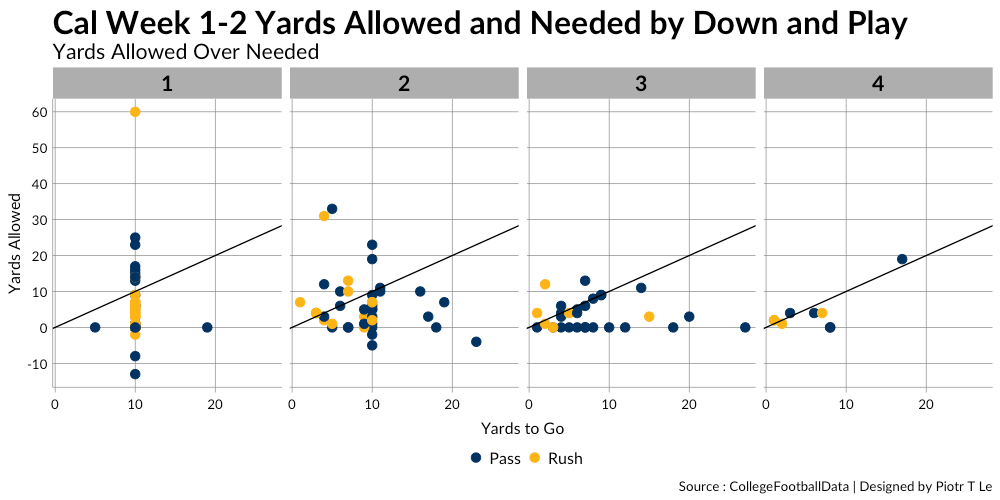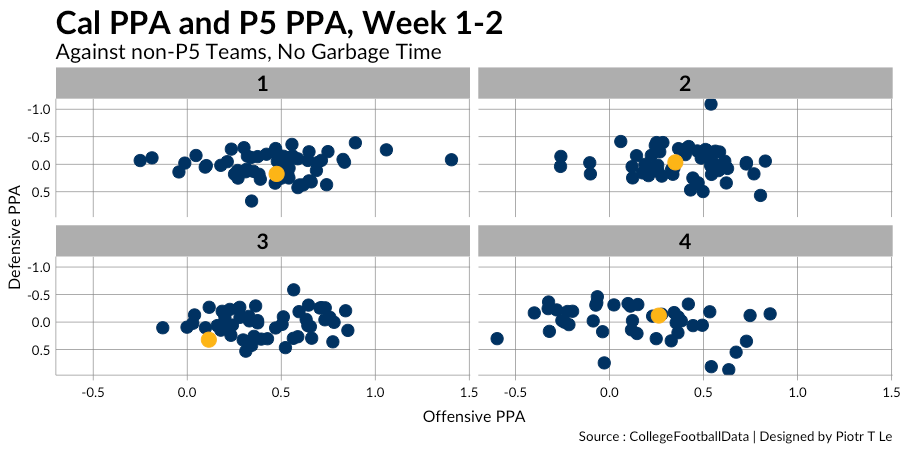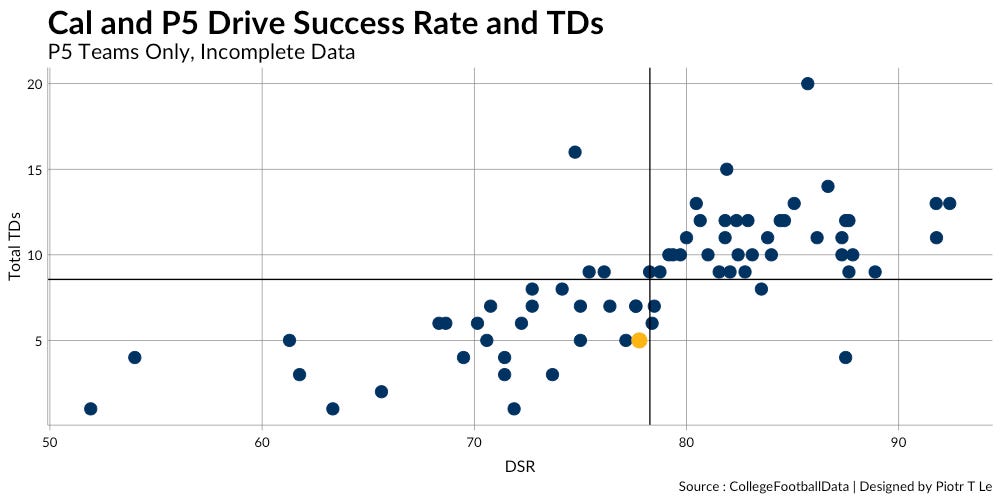Evans Hall: 3rd Quarter is Definitely Not Ours
And other things we can look at via a data lens
4th QUATER IS OURS
4th QUATER IS OURS
4th QUATER IS OURS
4th QUATER IS OURS
But definitely not 3rd quarter. And it has been a trend for the last two years. Looking at the offense:
So far in 2022: In the 1st Q Cal averaged 14 (6th in the nation) points and in the 3rd we scored 3.
So far in 2021: In the 1st Q Cal averaged 5.7 (66th in the nation) points and in the 3rd we scored 3.6 (120th in the nation).
So far in 2020: In the 1st Q Cal averaged 6.0 (61st in the nation) points and in the 3rd we scored 3.5 (110th in the nation).
So far in 2019: In the 1st Q Cal averaged 6.3 (57th in the nation) points and in the 3rd we scored 6.1 (64th in the nation).
Looking at it for this season it will continue as we struggle in the 3rd quarter to hold unto the game or the lead. This is a trend on the defense as well
So far in 2022: In the 1st Q Cal averaged 0 points allowed and in the 3rd we allowed 7.
So far in 2021: In the 1st Q Cal averaged 2.5 (4th in the nation) points allowed and in the 3rd we allowed 4.2 (21st in the nation).
So far in 2020: In the 1st Q Cal averaged 6.0 (61st in the nation) points allowed and in the 3rd we scored 4.3 (27th in the nation).
So far in 2019: In the 1st Q Cal averaged 5.6 (56th in the nation) points and in the 3rd we scored 5.8 (53rd in the nation).
We can see here that the defense takes a milder step back on defense but with the massive regression on offense we go down from a 3-4 advantage in Q1 to a ~1 deficit in Q3. Let’s take a look on how this looks for 2022.
Offensive Performance
by Quarter
We can see here that the offense moves well in Q1 with significant explosive moments early in the game only to fade in Q3: note the bump of the passing plays before the 0.0 line in the passing PPA. The rushing game was slightly more consistent quarter to quarter, this could be the answer for the stability of the offense. Rushing more in Q3 seems like a good way for the team to gain some stability.
We can see here that Q1 and Q2 have a lot of explosive plays as well as additional yards gained for the offense. This means that we’re not just getting 1st downs but a lot more to reduce the number of plays needed to score. The lack of explosive plays in Q3 makes the offense seem laborious.
by Down
Looking at how the offense is distributed by down and distance we can see that we remain a heavily passing offense regardless of down and distance on 3rd downs. Something worth noting is that 4 of the 5 sacks given up so far happened on 3rd and 5+, this is an obvious passing down situation where the defense can pin their ears and attack a QB who needs to let routes develop. Additionally, we can see that the 2nd down is seen as a chance for a big play through the air and on the ground.
Defensive Performance
by Quarter
Generally speaking, we have been keeping opposing teams unexplosive and forcing them to struggle for yards and big gains… until the 3rd quarter where most of the big gains the opposing team gets.
We can see here that in the Q3 the two big scoring rushes happened with the other quarters being contained to < 30-yard gains. Additionally, since both Davis and UNLV were behind Q4 was a pass-apalooza with the CAl defense forcing the lion share of sacks and TFLs.
by Down
Cal defense looks to struggle against the 2nd and short looks by the offense with a lot of them being converted above need at a higher clip than on other downs. What is very encouraging is that we have kept the opposing offenses struggling to see more than the bare minimum on 3rd down. Furthermore, the oppsing offense’s passing offenses remain contained by the Cal defense, forcing either short completions or incompletions.
Something worth looking into is the lack of negative plays on 3rd downs (ie. sacks) or the lack of stuffed run plays on early downs. Something worth looking into as we enter P5 play and the defensive playcalling opens up a bit more.
PPA Analysis by Quarter
We can see here that Cal in Q1/2 Cal offense and defense oscillated around average offense and good defense only to fall off into the “bad/bad” area in Q3 where Cal has to try to survive until the defense in Q4 comes to try to stop the Q3 bleeding.
DSR Review
As mentioned before DSR is a measure of efficiency but efficiency itself doesn’t win games, points do. And in this case we can see that Cal has placed itself right in the middle of the DSR ranking but is 2-4 TDs behind on the expected amount of TDs compared to it’s peers. Which is another point on the lack of execution in the redzone (see Plummer’s INT, Longhetto FGs attempts against UNLV).
Conclusion
Cal football struggles in the Q3 on both sides of the ball and it isn’t a recent development. Not 100% certain what the issue is: lack of self-scouting during the game causing the offense and defense to be caught off-guard in Q3? Lack of counters developed for any counters that the opponent can bring to the table? I think more and more teams can take advantage of Cal starting slow out of the break because if a schmuck like me can notice this on a spreadsheet, an actually competent GA can put cut-ups of the lack of play and focus around this.
Add in the predictable play-calling on 3rd downs for Cal’s offense, and we have a very worrying mix. Being predictable is great when one drives on the highway, but in college football it is a recipe for disaster. Let’s hope the staff can correct this issue coming into P5 play.


